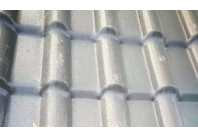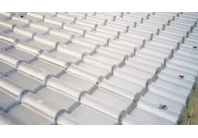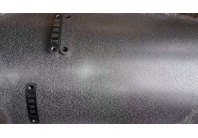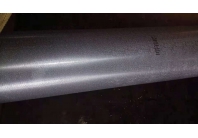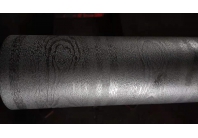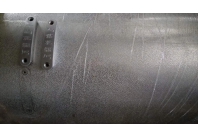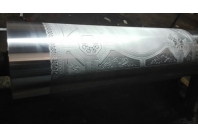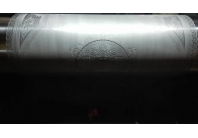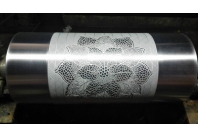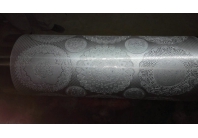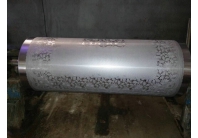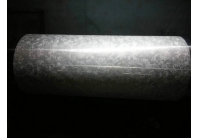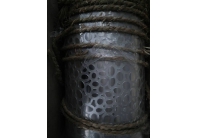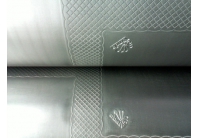- 压花辊制作时要注意的事项
- 本站编辑:杭州创兴花纹辊(杭州余杭区瓶窑镇创兴模具厂)发布日期:2020-03-05 15:25 浏览次数:
1. 下料:压花辊辊体用无缝钢管,轴用45圆钢,端板用Q235钢板, 按图纸尺寸留出8mm加工余量切料。
2. 车削加工:车削加工压花辊辊体、端板和轴等件的配合部位结合面,按H9/f9配合精度加工。
3. 焊接组合压花辊辊体内加强筋、两端轴等零件,注意校正两端轴与内套管的同轴度,只焊轴上的内端板。
4. 把组合焊接完整的内套装入压花辊辊体内,组合焊接内端板与压花辊辊体的配合交界处。
5.把外端板装在两端轴上,焊接外端板与轴和压花辊辊体的结合面交界处。
6. 对焊接组合的压花辊辊毛坯进行退火处理,消除内应力。
7.压花辊钢辊轴的一端车平端面,钻标准中心孔。
8.车削加工:分粗、精车压花辊钢辊体的各部位至图纸要求尺寸。压花辊辊体的工作表面粗糙度应不大于1.6μm;压花辊辊的工作面对两端轴支撑面(滚动轴承安装部位)径向跳动允差为0.025mm;压花辊辊体工作面的圆度为0.036mm;轴承配合圆按k6精度加工。然后架中心架,车端面,钻孔至尺寸。
9.按压花辊钢辊的图案要求加工花纹。然后镀硬铬层,厚度为0. 03~0. 05mm。
10.校正压花辊钢辊的静平衡。
花辊加工机械大理石自动磨边倒角机的组成
靠前部分主要是由磨头机构、板材输送装置、开槽装置等构成。其总体框架由型钢焊接成主体并固定在地面上。在框架上安装主轴磨头,磨头和倒角分成两组,分别对板材的两横边和两纵边进行加工。
磨头机构:由两个磨头组成,对板材两个相对的侧面进行倒角。两个主轴安装在传送带的两侧,主轴对板材侧边的工作压力通过气缸来调整。
板材输送装置:放在传送带上的板材可以水平旋转,板材由橡胶传送带进行输送,传送带为梯形并由液压减速器带动,传送带的速度可以通过减速器调节。
开槽装置:在设备传送带的底部安装两个或更多的金刚石锯片,当石材板通过锯片时,采用这种装置可以对板材的底面进行开槽,同时开槽的深度可以通过调整锯片的高度所确定。
在磨机架的侧面安装了一个控制柜,可以对加工过程进行监控。根据控制柜上所显示的板材尺寸对板材传送带速度进行自动调整。在定长磨削和倒角加工时,传送带的板材输送速度可通过液压变速器调节,并由控制柜的显示器进行显示。
第二部分主要由传送带、吹风机、干燥机、清洗机等组成。传送带由电动机带动,四边被加工的板材由传送带带动进行后续辅助处理。当板材经过吹风区时,风扇对板材的上下面进行刮板和吹风,清除板材表面的磨屑和杂质,然后板材继续前进到干燥区。干燥区由1m长的不锈钢薄板外罩组成,在罩内装有电阻加热器和热风循环机,对板材表面烘干。板材继续在传送带上向前运动,由布轮对表面清扫。在清扫区有两个回转布轮刷子,可以通过手动调整压力对板材清扫,在第二部位的支架侧面也有一个控制柜。
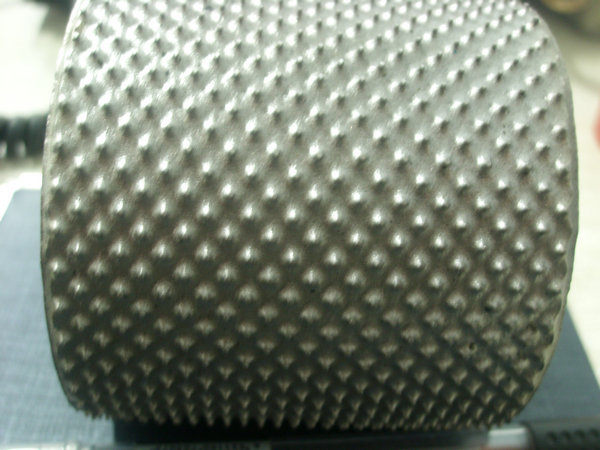

1. CUTTING: SEAMLESS STEEL TUBE for embossing roller body, 45 round steel for shaft, Q235 steel for end plate, 8 mm machining allowance for cutting according to drawing size. 2. TURNING: Turning the mating parts of embossing roller body, end plate and shaft, etc. , according to H9 / F9 mating precision. 3. The inner stiffener and two-end shaft of the welded composite embossing roller body should be adjusted to the coaxiality of the two-end shaft and the inner sleeve, and only the inner end plate of the shaft should be welded. 4. The combined welding complete inner sleeve is installed into the embossing roller body, and the combined welding inner end plate is at the Mating junction of the embossing roller body. 5. The outer end plate is mounted on the two end shafts, and the junction of the outer end plate and the shaft and the embossing roller body is welded. 6. The blank of the embossing roller is annealed to eliminate the internal stress. Kill. The flat end of one end of the steel roller shaft of the embossing roller is drilled with a standard center hole. 8. Turning processing: Dividing Thick, fine turning embossing roller steel roll body parts to the drawing required size. The work Surface roughness of the embossing roller body should not be more than 1.6 m; the radial runout allowance of the roller working face at the mounting position of the rolling bearing on the supporting surface of both ends of the roller body should be 0.025 mm; the roundness of the embossing roller body working face should be 0.036 mm; The bearing matching circle is processed according to K6 precision. Then frame center frame, car end face, drill hole to size. 9. Embossing Roller Steel Roller Pattern processing requirements. Then hard chromium layer, thickness of 0. 03 ~ 0. 05 mm. 10. Static balance of steel roller for emendation embossing roller. The first part is mainly composed of grinding head mechanism, plate conveying device, slotting device and so on. The overall frame is welded into the main body by the section steel and is fixed on the ground. A spindle grinding head is arranged on the frame. The grinding head and the Chamfer are divided into two groups, and the two transverse and two longitudinal edges of the plate are processed respectively. Grinding head mechanism: It is composed of two grinding heads to Chamfer two opposite sides of the plate. Two spindles are installed on both sides of the conveyor belt. The working pressure of the spindles on the side of the plate is adjusted by the cylinders. PLATE CONVEYOR: The plate placed on the conveyor belt can rotate horizontally, the plate is transported by the rubber conveyor belt, the conveyor belt is trapezoidal and driven by hydraulic reducer, the speed of the conveyor belt can be adjusted by the reducer. Slotting device: a device with two or more Diamond blade mounted at the bottom of a conveyor belt for slotting the underside of a stone plate as it passes through a saw blade, at the same time, the depth of the groove can be determined by adjusting the height of the saw blade. A control cabinet is installed on the side of the mill frame to monitor the process. According to the panel size displayed on the control cabinet, the speed of the panel conveyor is automatically adjusted. In fixed length grinding and chamfering, the conveying speed of the conveyor belt can be adjusted by hydraulic transmission and displayed by the display of the control cabinet. The second part is mainly composed of conveyor belt, hair dryer, dryer, cleaning machine and so on. The conveyor belt is driven by the motor, and the processed plates on the four sides are driven by the conveyor belt for subsequent auxiliary processing. When the plate passes through the blowing area, the fan carries on the scraping and blowing to the upper and lower parts of the plate to remove the debris and impurities on the surface of the plate, and then the plate goes on to the drying area. The drying zone consists of a 1m long stainless steel sheet cover, in which a resistance heater and a hot air circulation machine are installed to dry the surface of the sheet. The plate continues to move forward on the conveyor, and the cloth wheels clean the surface. There are two rotary cloth wheel brushes in the cleaning area, and the board can be cleaned by manually adjusting the pressure. There is also a control cabinet on the side of the bracket in the second position.

1. CUTTING: SEAMLESS STEEL TUBE for embossing roller body, 45 round steel for shaft, Q235 steel for end plate, 8 mm machining allowance for cutting according to drawing size. 2. TURNING: Turning the mating parts of embossing roller body, end plate and shaft, etc. , according to H9 / F9 mating precision. 3. The inner stiffener and two-end shaft of the welded composite embossing roller body should be adjusted to the coaxiality of the two-end shaft and the inner sleeve, and only the inner end plate of the shaft should be welded. 4. The combined welding complete inner sleeve is installed into the embossing roller body, and the combined welding inner end plate is at the Mating junction of the embossing roller body. 5. The outer end plate is mounted on the two end shafts, and the junction of the outer end plate and the shaft and the embossing roller body is welded. 6. The blank of the embossing roller is annealed to eliminate the internal stress. Kill. The flat end of one end of the steel roller shaft of the embossing roller is drilled with a standard center hole. 8. Turning processing: Dividing Thick, fine turning embossing roller steel roll body parts to the drawing required size. The work Surface roughness of the embossing roller body should not be more than 1.6 m; the radial runout allowance of the roller working face at the mounting position of the rolling bearing on the supporting surface of both ends of the roller body should be 0.025 mm; the roundness of the embossing roller body working face should be 0.036 mm; The bearing matching circle is processed according to K6 precision. Then frame center frame, car end face, drill hole to size. 9. Embossing Roller Steel Roller Pattern processing requirements. Then hard chromium layer, thickness of 0. 03 ~ 0. 05 mm. 10. Static balance of steel roller for emendation embossing roller. The first part is mainly composed of grinding head mechanism, plate conveying device, slotting device and so on. The overall frame is welded into the main body by the section steel and is fixed on the ground. A spindle grinding head is arranged on the frame. The grinding head and the Chamfer are divided into two groups, and the two transverse and two longitudinal edges of the plate are processed respectively. Grinding head mechanism: It is composed of two grinding heads to Chamfer two opposite sides of the plate. Two spindles are installed on both sides of the conveyor belt. The working pressure of the spindles on the side of the plate is adjusted by the cylinders. PLATE CONVEYOR: The plate placed on the conveyor belt can rotate horizontally, the plate is transported by the rubber conveyor belt, the conveyor belt is trapezoidal and driven by hydraulic reducer, the speed of the conveyor belt can be adjusted by the reducer. Slotting device: a device with two or more Diamond blade mounted at the bottom of a conveyor belt for slotting the underside of a stone plate as it passes through a saw blade, at the same time, the depth of the groove can be determined by adjusting the height of the saw blade. A control cabinet is installed on the side of the mill frame to monitor the process. According to the panel size displayed on the control cabinet, the speed of the panel conveyor is automatically adjusted. In fixed length grinding and chamfering, the conveying speed of the conveyor belt can be adjusted by hydraulic transmission and displayed by the display of the control cabinet. The second part is mainly composed of conveyor belt, hair dryer, dryer, cleaning machine and so on. The conveyor belt is driven by the motor, and the processed plates on the four sides are driven by the conveyor belt for subsequent auxiliary processing. When the plate passes through the blowing area, the fan carries on the scraping and blowing to the upper and lower parts of the plate to remove the debris and impurities on the surface of the plate, and then the plate goes on to the drying area. The drying zone consists of a 1m long stainless steel sheet cover, in which a resistance heater and a hot air circulation machine are installed to dry the surface of the sheet. The plate continues to move forward on the conveyor, and the cloth wheels clean the surface. There are two rotary cloth wheel brushes in the cleaning area, and the board can be cleaned by manually adjusting the pressure. There is also a control cabinet on the side of the bracket in the second position.
- 上一篇: 花纹压纹机正确操作步骤
- 下一篇:压纹机怎么样加速



